
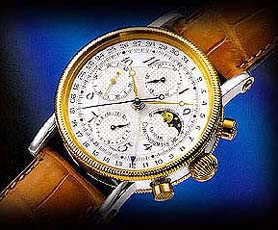
More chronos |
|
Chronoswiss belongs to the newcomers in the field of watchmaking that profited from the revived interest in mechanical time-pieces in the early 1980s. The company was founded by Gerd-Rüdiger Lang and is, despite its name, actually German, situated on the outskirts of Munich in Bavaria. |
|
|
Initially, Chronoswiss was not a manufacturer of watches: all the parts, cases, and movements were imported from Switzerland and assembled in Bavaria. Movements: Soprod, A. Rochat, ETA; cases: G. Ruedin, R. Prétat, Stila; dials: MOM Le Prélet, Les Geneveys s. Coffrance, F. Donzé; hands: Aiguilla, Universo; buckles: Boucledor. Said Herr Lang: "I see myself rather as a conductor: I know a little bit of everything and co-ordinate or conduct the various companies that participate, including my own." Most recently, Chronoswiss has graduated to a higher level and is now producing some of its own movements in-house. |
|
|
|
| With a watch that is historically as rich as the Omega Speedmaster, all sorts of opportunities arise to celebrate special occasions, and with its current focus on commercialism, Omega certainly does not miss any chances to commemorate notable moments in the Speedmaster's history by issuing special editions. In the middle is one of the "mission" series models of the Gemini program, and beside it on the right the replica of the first Speedmaster, as yet undiscovered by NASA, the "1957." On the left is the special edition for the 30th anniversary of the moon landing. This (limited??) edition series comprises 9999 pieces, numbered from 0001/9999 to 9999/9999, which are equipped with stainless steel cases and the manual-winding Omega caliber 861. The case back has the stamped replica of the Apollo 11 mission emblem surrounded by the engraving of the first words spoken by Neil Armstrong after the spacecraft landed: "HELLO HOUSTON, TRANQUILITY BASE HERE. THE EAGLE HAS LANDED" along with the date and the time of man's first steps on Moon "July 21, 1969 - 02:56 GMT." |
|
30 years after the Omega Speedmaster Professional accompanied the Astronauts to the Moon, Earth's faithful satellite makes its appearance on the face of the legendary "Moon Watch." The Omega Speedmaster Professional with Moon Phase and date indicator above on the right is equipped with a mechanical hand-winding chronograph movement and comes in an 18K white gold case. Desirable? Yes!!! |
| The HANHART watch factory was founded in 1882 in Diessenhofen, Switzerland, and later moved to the German town of Schwenningen. The company soon specialized in the production of chronographs, meeting the increasing demand for this type of timekeeping device by pilots in the twentieth century. After a post-war interruption, production of chronographs and stopwatches resumed in 1948, and after 1962, the company specialized in producing hand-held stopwatches and alarm clocks (oddly, the last time I looked, Hanhart's official German web site only contained stopwatches and clocks, no wristwatches). In 1997, production and administration were merged in the Black Forest community of Gütenbach, where it was decided - encouraged, no doubt by the mechanical revival of the 1990s - to reissue Hanhart's legendary 1939 Fliegerchronograph. Unlike any other chronograph I know, Hanharts have an asymmetrical placement of the pusher buttons, and since I have always liked odd things, this oddity immediately made it my favorite. It uses a modified ETA/Valjoux 7760 movement, ubiquitous, generic, but reliable and accurate, wound with the oversized crown. It has the same rotating fluted bezel with marking that is more familiar from Tutima Fliegers, and measures a substantial 40mm x 13.7mm. Another characteristic of the line is the special leather strap with safety rivets for that rugged fighter pilot look. The Hanhart Sirius on the right has the automatic ETA/Valjoux 7750 movement, automatic with date in the same distinctive style, more or less like adding power controls, air conditioning and cruise control to the beloved Porsche 911 to pamper the aging backs of enthusiasts. |
|
In Europe, the name JUNGHANS is nowadays most readily associated with high-tech watches and clocks. There are several lines of radio-controlled timepieces with attractive futuristic designs, offering the ultimate in timekeeping accuracy. It was not always like that, though, and the company's recent re-issue of its venerable Fliegerchronograph brought back a wave of memories for me. For my fifth birthday, one of my uncles gave me my first watch, a no-nonsense, hand-wound Junghans. I was somewhat dismayed by this, because up to that point, whenever I was late for dinner (often), which at our house was at 3:15 PM sharp, 1:15 on weekends, I had used the convenient excuse of not knowing what time it was. Thus began for me my time-regulated existence! |
||
| The Junghans stayed with me until Confirmation (my last participation in a Church activity), when one of my gifts was a SWISS automatic watch I had picked myself. In those days, and until quite recently, Swiss meant superior. I kept the automatic only a couple of years, until my electronic Tissot arrived. These years saw the beginning of my watch craze, which endures to this day. I don't have the slightest idea what happened to the Junghans, which is odd, because I was always quite meticulous with my possessions, and while I had forgotten about all of this for many years, it bothers me now. The Junghans Flieger re-issue is virtually identical to the 1955 original, except that the heart of that one was the beautiful Junghans J88 movement, while the new movement is an alien invader, the ETA/Valjoux 7760. Both are handwound. When scanning German second-hand watch sites, one can regularly come across the original Flieger, and the asking price is usually about equivalent to the price of the copy. |
|
| The Glashütte clan just keeps going, and anyone expecting something ordinary to arrive keeps getting bitterly disappointed. Among the eye poppers of an apparently blasé Basel 1999 watch fair was the new Lange&Söhne chronograph, the Datograph. As was the case with the Lange 1 or the Tourbillon "Pour le Mérite," one is initially stunned by the design, a combination of never-before-seen and a strong sense of traditionalism, then overwhelmed by the technical aspects. As with the simultaneously introduced Moonphase, the more I read about the Datograph, the more I was left in absolute awe. It reminds me of the time years ago when I first read about IWC's Grande Complication and could not believe anyone would spent time and effort on producing such a marvel. Lange introduced the outsized date, and while some were critical of its aesthetics, most were lusting for a watch with this feature. Not surprisingly, we can now find it on several watches, including Lange's "sister" company, Glashütte Original. Datograph is flanked by two recent Glashütte models. If only they could make them cheaper! |
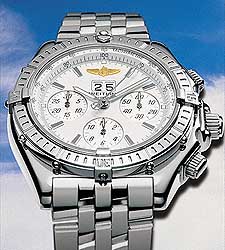 |
The company that is "the choice of professionals" apparently knows a good thing when it sees it, and, aided by a new ETA movement that brings a breath of egalitarianism to the oversized date, now has its own chrono with big date. I wonder what other trends will eventually be traced back to Lange. On the right something more traditional: the KonTiki chrono by ETERNA. This often overlooked company, now owned by Porsche, has been one of my choice timepieces ever since I read the stories about Thor Heyerdahl's exploits. Heyerdahl , the Norwegian ethnologist and author, won fame in 1947 by sailing a balsa-wood raft named Kon-Tiki from Peru to the Tuamotu Islands in eastern Polynesia. | 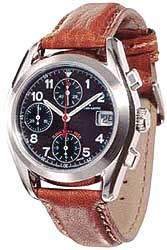 |
| He and five companions made the trip to test his theory that the islands of Polynesia could have been settled by Indians from South America. His book, Kon-Tiki (1950), tells the story of the voyage. In 1958, he wrote Aku-Aku, a book about Easter Island. In 1970, Heyerdahl and a crew of seven sailed a papyrus reed boat named Ra-2 from Morocco to Barbados in the West Indies. He claimed that this voyage proved that the ancient Egyptians could have sailed similar boats to the New World. You don't necessarily have to be a dreamer to desire a watch from the KonTiki line! |
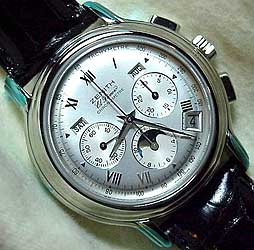 |
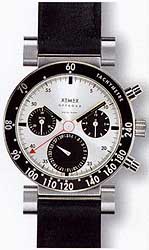 |
| When deciding to purchase a
chronograph, the choices seem endless. One of the
youngest Swiss companies is called XEMEX,
and it highlights the designs of Ruedi Külling. Neither
these nor the equally unorthodox models by Ventura,
such as the V-matic chrono here on the left, are to
everybody's liking: one has to be a devotee of design
above all else, like buyers of Bang and Olufsen stereos,
to find satisfaction with these watches. Being a
conservative at heart, I would most certainly be more
comfortable with the stunning yet traditional Zenith in
the middle. Still, whoever can afford to do so should
consider the purchase of something like the DaVinci
chrono with century display, now available in more
affordable stainless steel. No matter where you may be on
December 31st, 1999, to witness the change of the display
from 1999 to 2000 would truly be the event of a lifetime!
For a guided tour of the IWC factory, click on the
DaVinci! On the other hand, you might want to start saving your money for the latest stunner from BLANCPAIN: an automatic tourbillon chronograph, very rare, very expensive! |
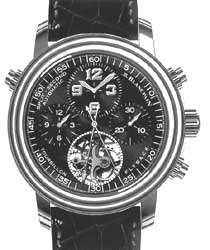 |
| Page 1: hello |
Page 2: nice things |
Page 3: Audemars Piguet |
Page 4: IWC, JLC |
Page 5: Patek Philippe |
| Page 6: Flieger |
Page 7: more Flieger |
Page 8: Zenith, Eberhard |
Page 9: chronographs |
Page 10: big money! |
| Page 11: mo' money |
Page 12: more chronos |
Page 13: less known gems |
Page 14: still constructing |
Page 15: pictures & links |